Last updated: June 21, 2022
Article
Ulysses S. Grant in St. Louis 1854-1860
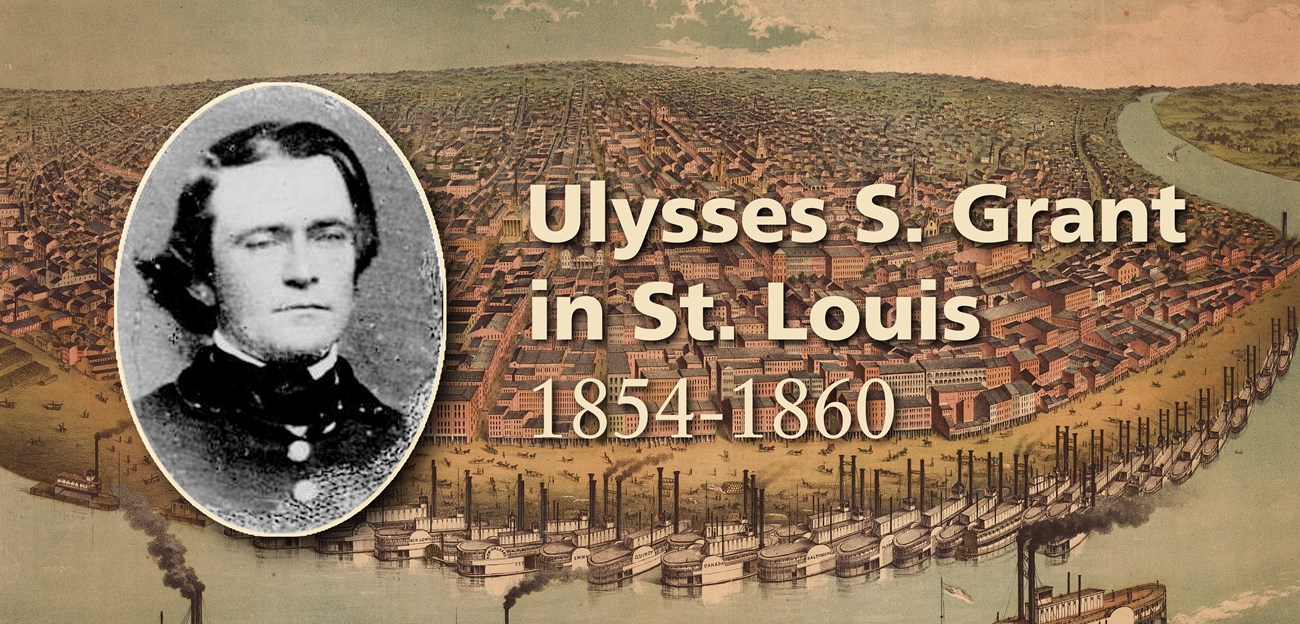
NPS Photo / Library of Congress
A Journey of Self Discovery
For nearly six years before the American Civil War, future general Ulysses S. Grant called St. Louis, Missouri home. These years proved to be some of the most formative in his life. Grant confronted slavery for the first time on a daily basis, struggled to find a civilian career, and attempted to secure a new home for his growing family.
A Man on the Move
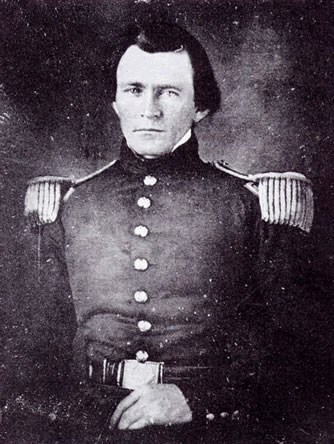
Dashing Lieutenant Grant
Upon graduating from the United States Military Academy at West Point in 1843, Grant was ordered to join the 4th U.S. Infantry at Jefferson Barracks in St. Louis, Missouri. During his stay at the barracks, Grant's became acquainted with his West Point roommate's younger sister, Julia Dent, who lived nearby on the White Haven estate. After a brief courtship, Grant proposed marriage at White Haven and the young couple was married in St. Louis in 1848. Ulysses and Julia spent the next several years traveling from one army base to the next, but St. Louis and White Haven remained an achor in their lives.
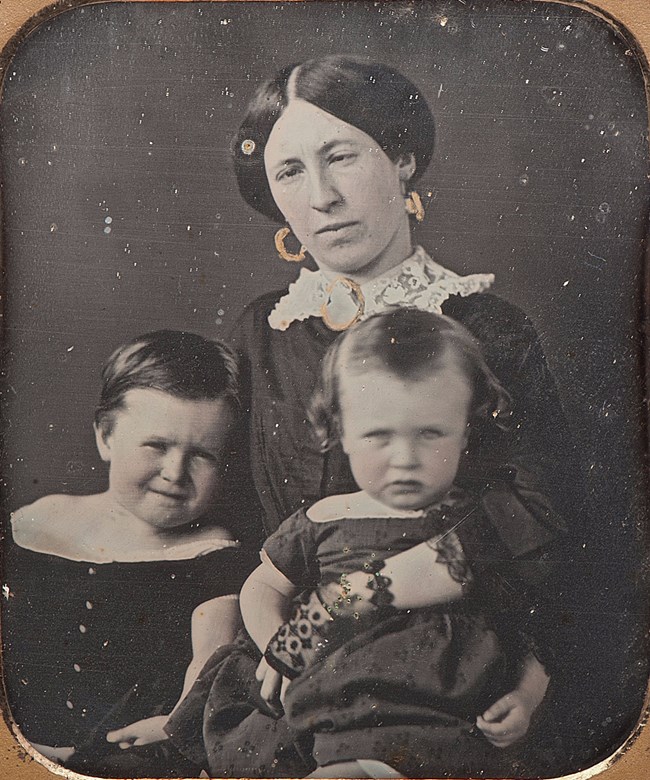
NPS Photo
Homecoming
From 1848 to 1852 Julia Grant, and later baby Fred, accompanied Ulysses S. Grant as he moved from St. Louis to Sackets Harbor and then to Detroit. Being with his family was very important to Grant, who cared more for his loved ones than anything else in his life. Unfortunately, in 1852, Grant was reassigned to Fort Vancouver on the Pacific West Coast. Julia was unable to accompany him because she was pregnant with their second child and the journey was a dangerous one that required the 4th Infantry to cross the Isthmus of Panama to reach the West Coast. Grant was forced to leave his family behind at White Haven. He did not know at the time that he would miss the birth of his second child and not see Julia and his young children for over two years. Though Grant could not be with his family on the West Coast, he took comfort in the memories he had made while at home and stayed in touch with Julia and the children through letters.
On January 29, 1853 Ulysses S. Grant wrote from Fort Vancouver, Oregon Territory, to his wife Julia at White Haven. He was responding to a letter from Julia, which included details about their children.
I will now notice your last sweet letter. It was one of the most interesting letters I have received, because it told me so much about our dear little ones…It made my tears almost start in my eyes, with joy, to hear so much about them by one Mail. I only wish dearest that I could be there to look upon them now, and see my dear wife again.
In 1854, after two and a half years of isolation from his family Captain Ulysses S. Grant resigned his comission from the Army and began his long journey home to St. Louis to be with his loved ones.
Watch the video below to learn more about Ulysses and Julia's love story and thier time apart in the 1850s.
- Duration:
- 4 minutes, 9 seconds
Despite hardship, family conflicts, and extended separation during two American wars, Ulysses and Julia Grant's love for each other remained constant. Watch this short video to learn about their remarkable true love story.
A Place Called Home
Life as an army officer meant that Grant and his family were frequently forced to relocate to a new army base or outpost. As a civilian, Ulysses aspired to finally establish a stable home for his family in the St. Louis area. Although he desired a permanent home, Ulysses ended up living in five different houses in just six years. Below is a timeline of the homes that Ulysses lived in while in St. Louis.
1854
Grant lives at White Haven with Julia, Frederick, and Ulysses S. Grant Jr. as well as his father-in-law Frederick Dent, mother-in-law Ellen Dent, and sister-in-law Emma Dent.
1855-October 1856
Ulysses, Julia and their children live at Wish-ton-wish while Grant constructs Hardscrabble.
October 1856-January 1857
Ulysses, Julia and the children live at Hardscrabble near Rock Hill Road.
January 1857-February 1859
Ulysses and his family return to White Haven following the death of Julia's mother, Ellen. Grant's father-in-law, Col. Frederick Dent moves to his townhouse at 4th and Cerre Street.
March-October 1859
Ulysses rents a house at 7th and Lynch Street. Julia and the children eventually join him at the residence in April.
October 1859-May 1860
Ulysses, Julia and the children live in a house at 9th and Barton street in St. Louis City.
Scroll down to learn more about Ulysses S. Grant's homes in St. Louis. Click on the links to learn more about each residence.
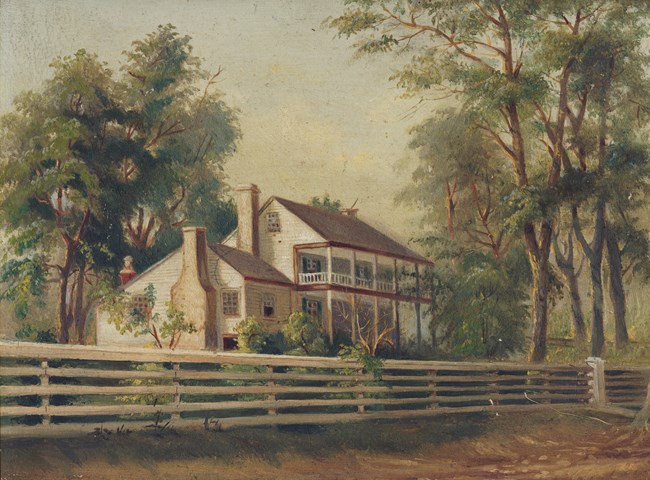
NPS Photo
White Haven
"My first recollections . . . were on the south end of the front piazza at our old home, White Haven. Dear papa, coming out with seeming great pleasure, caught me up and held me high in the air, telling me to look, the very trees were welcoming me . . . I watched too the white clouds flying across the blue sky. All this I distinctly remember." - Julia Dent Grant
The White Haven estate was built between 1812 and 1816 and was the childhood home of Julia Dent Grant. Ulysses and Julia met and fell in love on the property during a four month courtship in 1844 and later lived in the home with their children in the 1850s. Following the Civil War, Ulysses purchased the farm from his in-laws with the intent of retiring on the estate and raising horses, although this plan evaporated during his presidency, and Ulysses and Julia later moved to New York City instead.
- Watch a ranger guided virtual tour of White Haven here.
- Learn about the people who lived at White Haven here.
- How was White Haven saved from demolition and converted into a National Historic Site in 1989? Read the story of the grassroots movement, Save Grant's White Haven here.
- White Haven Then and Now: Look at the historic and modern photos of the White Haven estate on this page. Use the slider tool to compare the photos. Do you see any differences between the historic photos and today?
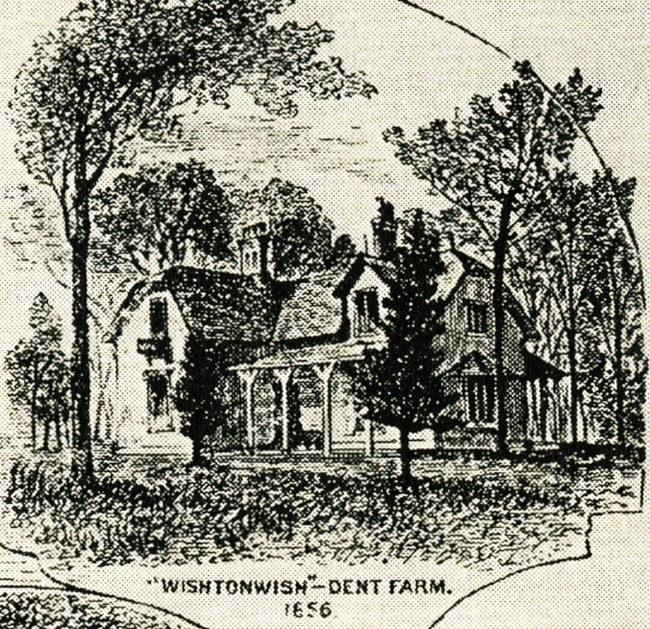
Wish-ton-wish
In the spring, we went up to Wish-ton-wish, which belonged to my brother Louis (Judge Louis Dent), but, as he was called back to California, he was delighted to have us occupy it. -Julia Dent Grant
Wish-ton-wish was built by Julia's brother a half-mile south of the White Haven home on the present-day Grant's Farm property. Julia enjoyed their time at Wish-ton-wish which she decsribed as a "beautiful English villa...situated in a primeval forest of magnificant oaks". The home was destroyed by a fire in 1873 during Grant's presidency.
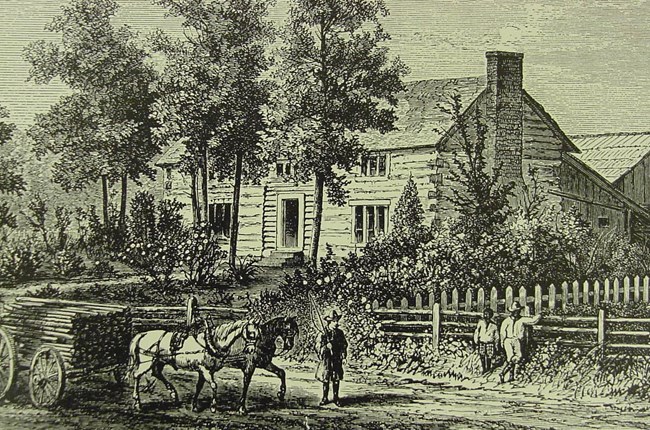
Hardscrabble
I suppose the Captain was tired of going so far to his farm and decided to build. He thought of a frame house, but my father most aggressively urged a log house saying it would be warmer. So the great trees were felled and lay stripped of their boughs; then came the house-raising and a great luncheon...We went to this house before it was finished and lived in it scarcely three months. It was so crude and homely I did not like it at all, but I did not say so. - Julia Dent Grant
Eager for a home to call his own, Ulysses S. Grant began working on a log cabin for his family in 1855. At the time, Ulysses was farming the 80 acre property a half-mile north of White Haven and wanted a new home close to the fields. Although Grant labored to build the house, Julia did not care for it and the Grant family soon moved back to White Haven following the death of Julia's mother, Ellen.
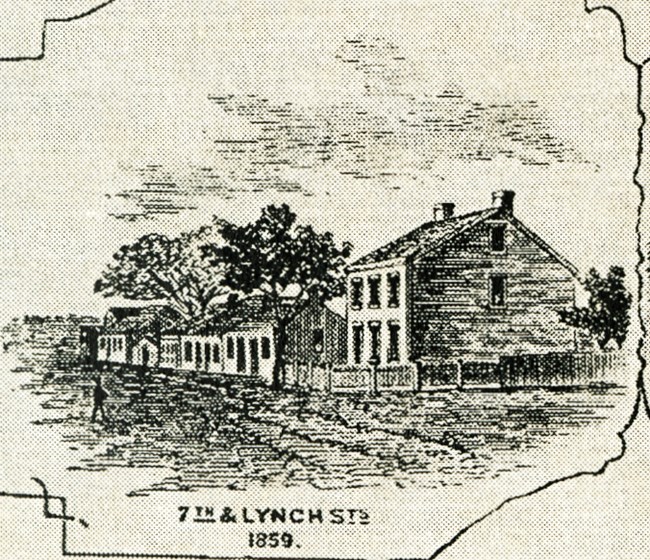
7th and Lynch Street
"The Captain went in March and secured a neat little house for us which was simply but comfortably furnished." -Julia Dent Grant, Personal Memoirs
Grant wrote to his father, Jesse Grant in March of 1859 describing the accommodations in their new house:
"We have one spare room and also a spare bed in the childrens room so that we can accommodate any of our friends that are likely to come see us." -Ulysses S. Grant to Jesse R. Grant, March 12, 1859
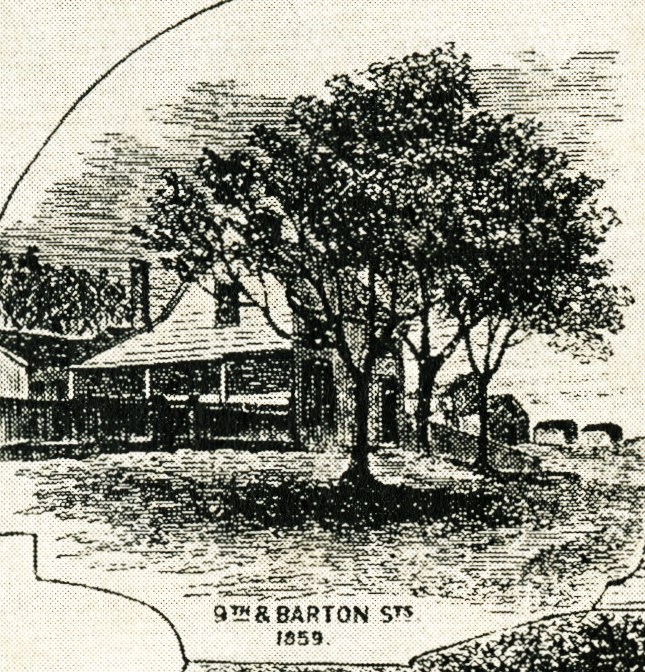
1008 Barton Street
In October 1859, the Grants moved to a home at the intersection of 9th and Barton Streets. In describing this home to his brother Simpson on October 24th, Grant stated:
"My family are all well and living in our own house. It is much more pleasant that where we lived when you were here and contains about as much room, practically."
The Grants remained at this house until moving to Galena, Illinois in the spring of 1860.
Confronting Slavery
Ulysses S. Grant was raised in Georgetown, Ohio where slavery was not only illegal and but also frowned upon by most of his neighbors. Grant's own father, Jesse was a known opponent of slavery who wrote articles for a local periodical harshly criticizing slaveholders and the institution of slavery as a whole. Given the fact that Ulysses was raised in an anti-slavery household, it comes as a surprise to many that he later lived on farm run with slave labor and even owned an enslaved man himself. Grant's exposure to, and participation in, the institution of slavery while in St. Louis had a profound impact on his life and work as a general and president.
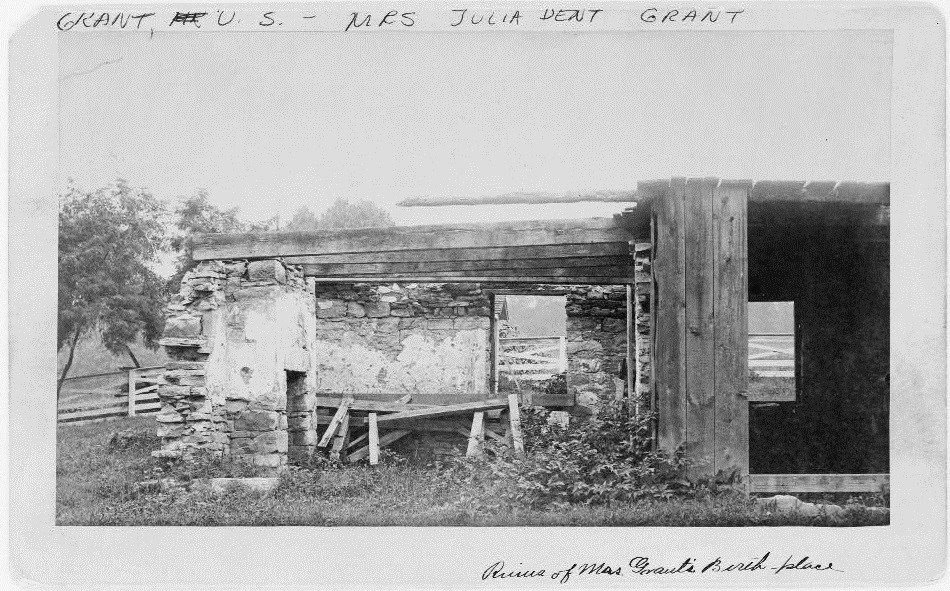
Library of Congress
Slavery at White Haven
At his in-law's farm Ulysses came face to face with the institution of slavery on a daily basis for the first time in his life. While Grant's parents condemned the act of owning humans, Grant's father-in-law, Col. Frederick Dent viewed slavery as a necessary institution. Dent's farm, White Haven was run on the back of enslaved African-Americans who labored in the fields, cared for the Dent and Grant children, and supported a high standard of living enjoyed by both families at the main house.As an associate of Col. Dent's, Ulysses occasionally worked alongside enslaved African Americans and became acquainted with the Dent's cook Mary Robinson who recalled her memories of Grant in an interview with the St. Louis Republican on July 23, 1885.
Read the full story of slavery at White Haven here.While on his farm Grant entertained a great deal of company, including officers from Jefferson barracks who called on him frequently. At home he often expressed his opinion about people, and I never knew him to make a single mistake in judging a man's character. I saw him last at the Lindell hotel, after he returned from his trip around the world, and he received me very kindly and it seemed to me that he was mighty glad to see me. -Interview with Mary Robinson, St. Louis Republican
Watch the video below to learn more about slavery at White Haven.
- Duration:
- 4 minutes, 16 seconds
Ulysses S. Grant was one of the great civil rights presidents in American history. His legacy on behalf of African American citizenship laid the foundation for future generations. Yet in the 1850s, he lived among African American slaves.
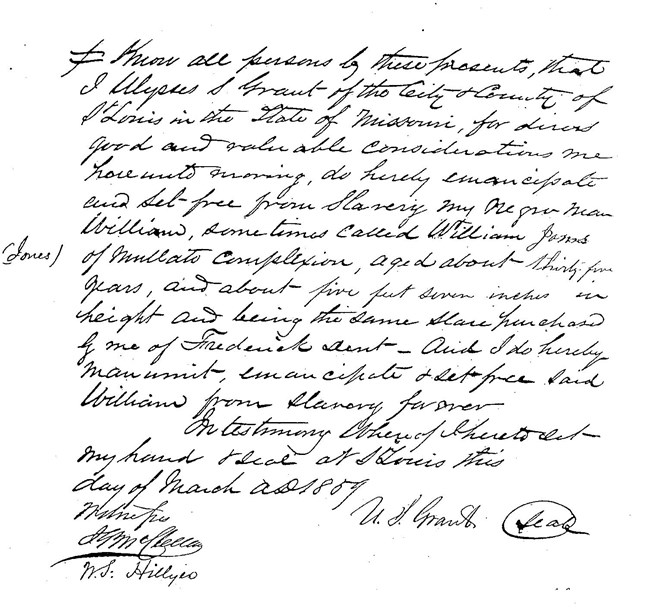
Missouri Historical Society
William Jones
At some point during Grant’s time at White Haven he acquired ownership of an enslaved man named William Jones from his father-in-law Frederick Dent. Although financialy destitute at the time, Ulysses S. Grant emancipated William at the St. Louis Courthouse in 1859 rather than selling William for profit. Read more about William Jones here.Searching for a Civilian Career
Upon resigning from the army in 1854 Ulysses made his way back to live with his family at White Haven. In giving up a stable career with the military, Grant was gambling that he would be able to find a steady civilian career in St. Louis. However this proved more difficult than he could have ever imagined. Over the course of six years Grant bounced from one job to the next, but none earned him the financial security that he desired to support his growing family."Whoever hears of me in ten years, will hear of a well-to-do Missouri farmer" -Ulysses S. Grant to a fellow soldier at Fort Humbolt, 1854
Scroll down to learn more about Ulysses S. Grant's various jobs in St. Louis.
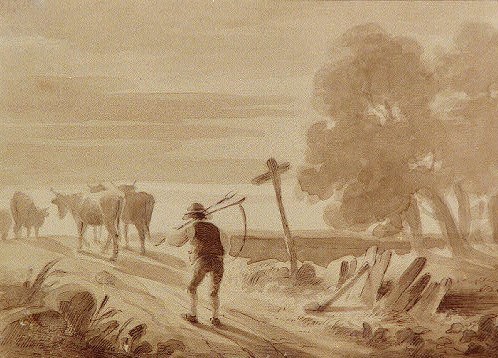
Library of Congress
Farmer Grant
Ulysses S. Grant tried his hand at farming at White Haven in the mid-1850s. Initially he worked as a farm hand on the estate, but when Col. Dent moved to the city in 1857, Grant took full control of day-to-day operations on the farm. As a farmer Grant faced numerous obstacles including droughts, personal illness, a failing economy and unseasonable frosts due to the “Little Ice Age”. Despite his best efforts, Grant could not make a living as a farmer and he and Dent agreed to sell off most of their farm equipment in late 1857.
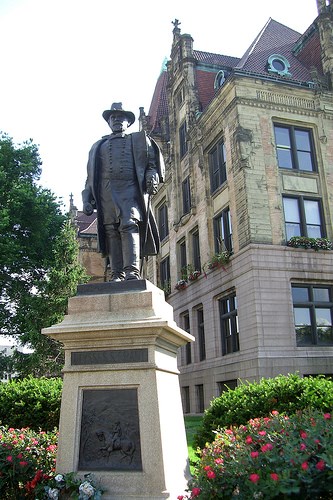
NPS Photo
Firewood Salesman (1854-1858)
Another profession of Grants was that of a firewood salesman and delivery man. Ulysses felled oak and hickory trees on the 80 acre Hardscrabble farm, split the trunks, and packed chords for delivery in the city. He made a modest amount of money peddling his firewood, but could not sustain his family on this income alone.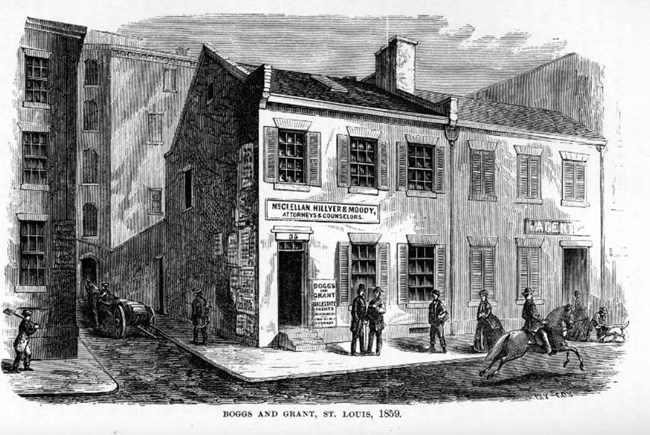
Library of Congress
Boggs and Grant: Real-estate Agents (1859)
In 1859 Ulysses formed a partnership with Julia’s cousin Harry Boggs and the two opened a real-estate business in St. Louis City. Boggs managed the business, while Grant was responsible for collecting rent from their tenants. After Grant failed to successfully collect rent owed to the company on multiple occasions, he and Boggs decided to dissolve their partnership.
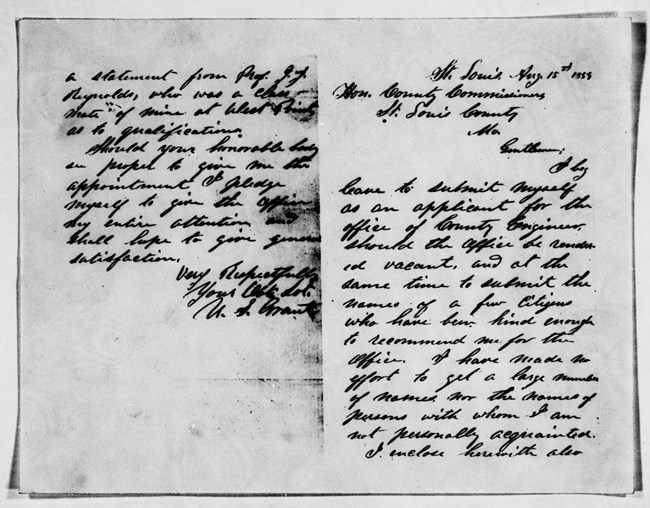
Library of Congress
Ulysses Grant, County Engineer? (1859)
After the disbandment of Grant and Boggs Real Estate, Grant decided to apply for the position of St. Louis County Engineer. He had been trained in engineering and excelled in mathematics while at West Point, making him a good fit for the position. Charles F. Salomon, a German-born engineer who would later serve under Grant during the Civil War, also applied for the job. A three-person commission evaluated the credentails of both men and eventually chose Salomon for the position.
"Rodney H. Wells, when he was later postmaster of St. Louis, would declare that Grant had waited on the courthouse steps for the result, and that when a friend emerged saying, 'You're beaten,' Grant had said, 'Yes, and by a Dutchman.'" -Lloyd Lewis, Captain Sam Grant
![U.S. Post Office and Custom House 218 N. 3rd Street St. Louis [demolished 1941] Black and white photo of a multistory 19th century office building with large columns](/ulsg/images/U_12.jpg?maxwidth=650&autorotate=false)
Grant at the U.S. Customs House (1859)
“Grant wrote home that his name had been forwarded for the appointment of superintendant of the custom house. ‘I am still unemployed,’ he said, ‘but expect to have a place in the custom house from the first of next month.’ He explained that if he was not appointed superintendent he was to get a desk as a clerk in the custom house. He did receive the clerkship, but it lasted only about a month.” -Grant in St. Louis
